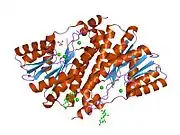HSD17B11
Estradiol 17-beta-dehydrogenase 11 is an enzyme that in humans is encoded by the HSD17B11 gene.[5][6][7][8]
References
- GRCh38: Ensembl release 89: ENSG00000198189 - Ensembl, May 2017
- GRCm38: Ensembl release 89: ENSMUSG00000029311 - Ensembl, May 2017
- "Human PubMed Reference:". National Center for Biotechnology Information, U.S. National Library of Medicine.
- "Mouse PubMed Reference:". National Center for Biotechnology Information, U.S. National Library of Medicine.
- Brereton P, Suzuki T, Sasano H, Li K, Duarte C, Obeyesekere V, Haeseleer F, Palczewski K, Smith I, Komesaroff P, Krozowski Z (January 2001). "Pan1b (17betaHSD11)-enzymatic activity and distribution in the lung". Molecular and Cellular Endocrinology. 171 (1–2): 111–7. doi:10.1016/S0303-7207(00)00417-2. PMID 11165019. S2CID 54263651.
- Chai Z, Brereton P, Suzuki T, Sasano H, Obeyesekere V, Escher G, Saffery R, Fuller P, Enriquez C, Krozowski Z (May 2003). "17 beta-hydroxysteroid dehydrogenase type XI localizes to human steroidogenic cells". Endocrinology. 144 (5): 2084–91. doi:10.1210/en.2002-221030. PMID 12697717.
- Persson B, Kallberg Y, Bray JE, Bruford E, Dellaporta SL, Favia AD, Duarte RG, Jörnvall H, Kavanagh KL, Kedishvili N, Kisiela M, Maser E, Mindnich R, Orchard S, Penning TM, Thornton JM, Adamski J, Oppermann U (March 2009). "The SDR (short-chain dehydrogenase/reductase and related enzymes) nomenclature initiative". Chemico-Biological Interactions. 178 (1–3): 94–8. doi:10.1016/j.cbi.2008.10.040. PMC 2896744. PMID 19027726.
- "Entrez Gene: HSD17B11 hydroxysteroid (17-beta) dehydrogenase 11".
Further reading
- Li KX, Smith RE, Krozowski ZS (1999). "Cloning and expression of a novel tissue specific 17beta-hydroxysteroid dehydrogenase". Endocrine Research. 24 (3–4): 663–7. doi:10.3109/07435809809032667. PMID 9888557.
- Haeseleer F, Palczewski K (2000). "Short-chain dehydrogenases/reductases in retina". Methods in Enzymology. 316: 372–83. doi:10.1016/S0076-6879(00)16736-9. PMID 10800688.
- Hartmann TB, Thiel D, Dummer R, Schadendorf D, Eichmüller S (February 2004). "SEREX identification of new tumour-associated antigens in cutaneous T-cell lymphoma". The British Journal of Dermatology. 150 (2): 252–8. doi:10.1111/j.1365-2133.2004.05651.x. PMID 14996095. S2CID 42495130.
- Otsuki T, Ota T, Nishikawa T, Hayashi K, Suzuki Y, Yamamoto J, Wakamatsu A, Kimura K, Sakamoto K, Hatano N, Kawai Y, Ishii S, Saito K, Kojima S, Sugiyama T, Ono T, Okano K, Yoshikawa Y, Aotsuka S, Sasaki N, Hattori A, Okumura K, Nagai K, Sugano S, Isogai T (2007). "Signal sequence and keyword trap in silico for selection of full-length human cDNAs encoding secretion or membrane proteins from oligo-capped cDNA libraries". DNA Research. 12 (2): 117–26. doi:10.1093/dnares/12.2.117. PMID 16303743.
- Kimura K, Wakamatsu A, Suzuki Y, Ota T, Nishikawa T, Yamashita R, Yamamoto J, Sekine M, Tsuritani K, Wakaguri H, Ishii S, Sugiyama T, Saito K, Isono Y, Irie R, Kushida N, Yoneyama T, Otsuka R, Kanda K, Yokoi T, Kondo H, Wagatsuma M, Murakawa K, Ishida S, Ishibashi T, Takahashi-Fujii A, Tanase T, Nagai K, Kikuchi H, Nakai K, Isogai T, Sugano S (January 2006). "Diversification of transcriptional modulation: large-scale identification and characterization of putative alternative promoters of human genes". Genome Research. 16 (1): 55–65. doi:10.1101/gr.4039406. PMC 1356129. PMID 16344560.
This article is issued from Wikipedia. The text is licensed under Creative Commons - Attribution - Sharealike. Additional terms may apply for the media files.







